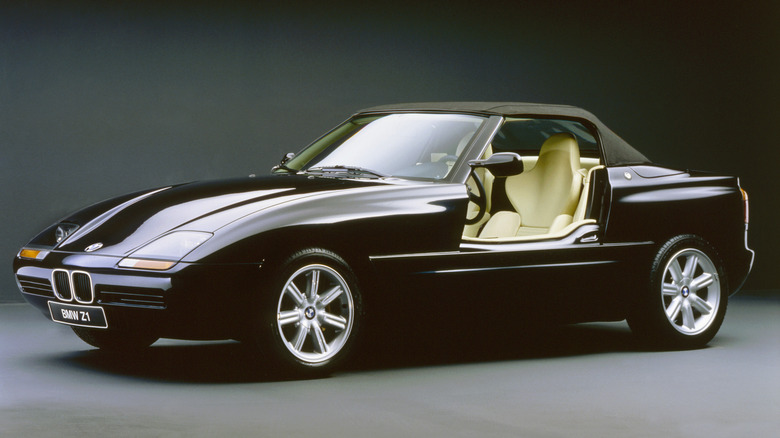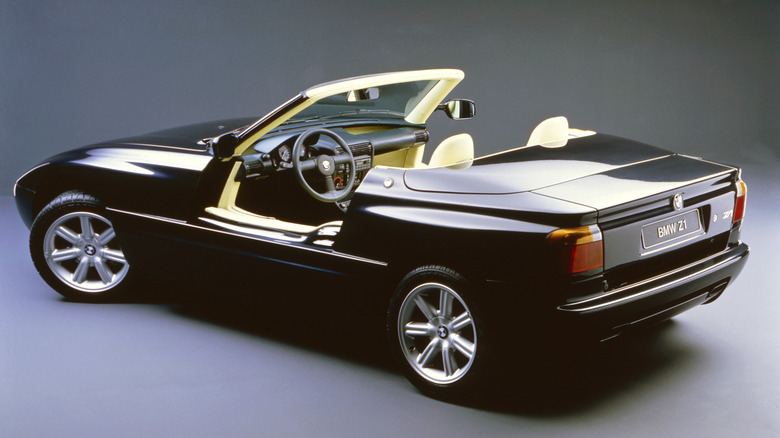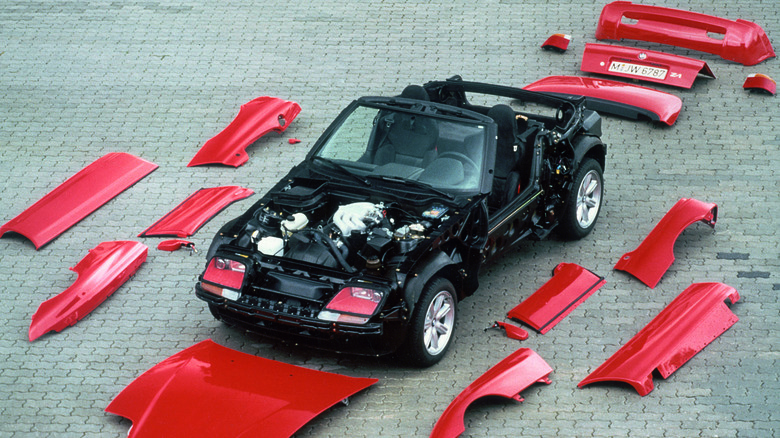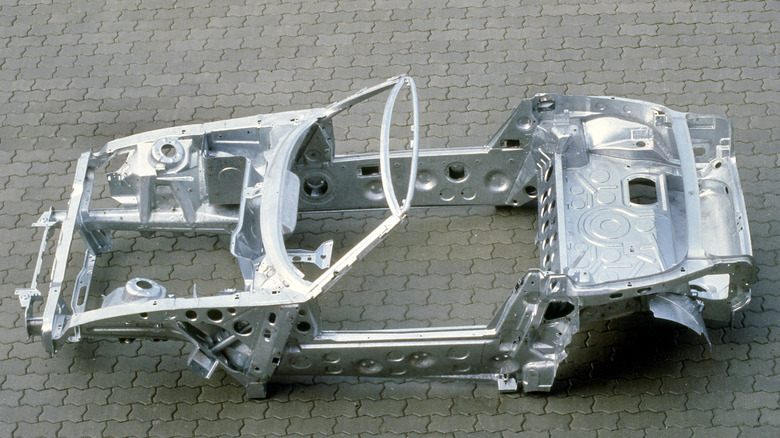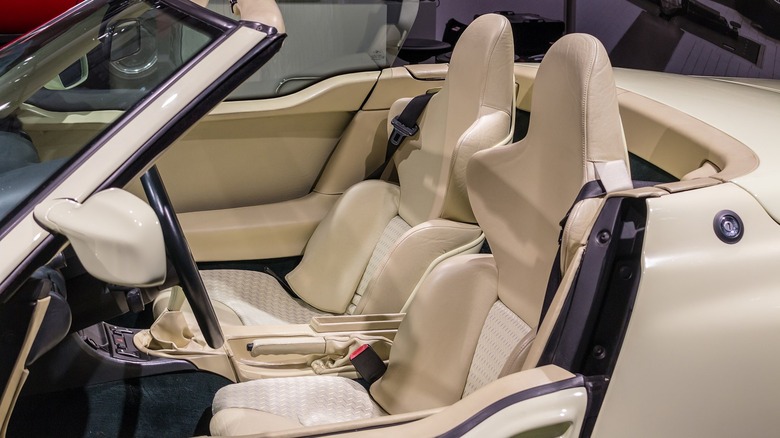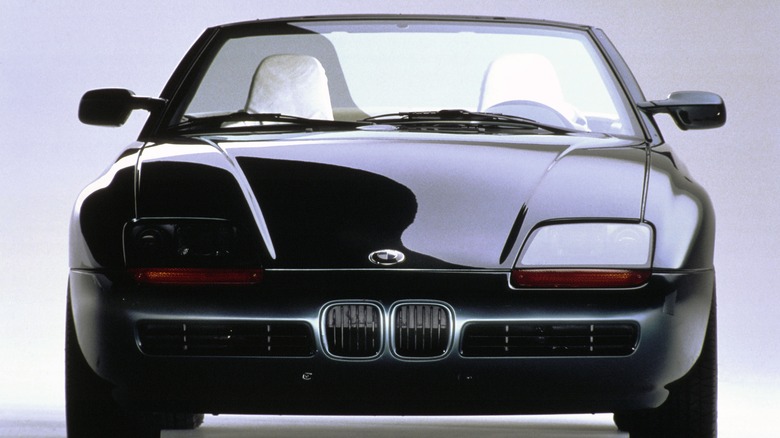The 5 Coolest Features Of The BMW Z1
Back in 1985, BMW decided to let a team of talented designers and engineers run free in a sort of avant-garde "think tank," known as BMW Technik, located several miles from the company headquarters in Munich. The team's first project was a sports car known as the Z1, which was developed simultaneously as a roadster as well as a coupe with a wagon-style rear clip, not unlike the later Z3 coupe. But at the time, management shelved the coupe while the roadster received the green light for production, filling a void in BMW's lineup since the model 507 roadster was discontinued in 1959.
Because the Z1 roadster was quirky and complicated to manufacture, with much of the vehicle made by hand, only 8,000 units total were sold in a production run that lasted from 1989 to 1991. Most of the 8,000 vehicles were sold domestically in Germany, though Italy and France also received a small allotment. The roadster was never officially sold in the United States, although some have been imported by collectors over the years.
The Z1's engine is a 2.5-liter straight-six cylinder, backed by a five-speed manual transmission, both pulled directly from the E30 325i. With only about 170 horsepower, the roadster took 7.9 seconds to accelerate from zero to 60 mph. While that number wasn't overly impressive, the car reportedly handled well and was fun to drive. But the real hype surrounding the Z1 came from the unconventional design elements that make it a cult classic today.
Pop-up doors
Since any discussion of the Z1 inevitably revolves around its unique door situation, let's just get that out of the way first. Instead of opening outwards like most cars, or even pivoting upward like Lamborghini's hallmark scissor doors, the Z1's doors retract vertically into the body of the car. Even more impressive, the whole process is automated via a system of electric motors and rubber belts.
The exterior door "handle" is actually a cylinder mounted in the bodywork just behind the doors. The cylinder can be turned with a key to lock and unlock the doors, which is pretty typical, but to raise or lower the doors, the cylinder must be pressed inward. The interior door handles are quite normal looking, except for the fact that they're mounted so low, next to the occupants' legs. Oddly, there's no way to lock the car from the inside, so it's probably best to avoid carjacking scenarios when driving your Z1.
Speaking of driving your Z1, there are no safety devices to prevent owners from driving the car with the doors in the down position, which goes to show that Jeeps aren't the only game in town for doorless driving.
Removable plastic body panels
In a fit of either genius or insanity, BMW engineers equipped the Z1 with plastic body panels that can be completely removed, exposing the vehicle's chassis. Why on Earth would it do that? BMW reasoned that Z1 owners might wish to purchase an extra set of body panels in a different hue, allowing owners to change the car's color when the mood strikes.
According to BMW, the body panels could be completely swapped out in a time of 40 minutes which seems incredibly optimistic because it is. In 2014, the British television show "Wheeler Dealers" reportedly took six hours to swap their Z1 bodywork from yellow to red. Because the thin plastic body panels lack rigidity, BMW had to use a special paint with flex agents added to prevent the finish from cracking with movement. On the plus side, it's possible — née, encouraged – to drive the Z1 without any of its body panels installed, like a giant go-cart.
Windshield-mounted roll bar
Certain convertible cars feature a roll bar, a sturdy tubular frame designed to keep passengers safe in the event of a vehicle rollover. Typically mounted behind the seats, some roll bars are fixed while others are normally hidden, but rapidly deploy in the event of a crash. Leave it to the Z1 to eschew both of those approaches. Its roll bar is built into the front windshield frame, which makes sense when you really think about it.
Entering and exiting the Z1 is difficult because of the incredibly high door sills necessary to house the retractable doors when lowered. An occupant's first inclination might be to grab the windshield frame for support, except that most convertible windshield frames aren't designed to withstand that sort of load repeatedly without bending or breaking.
Well, the Z1 was designed with a heavy-duty roll bar integrated into the front windshield frame which reportedly can support the weight of the entire car. The top bit of the roll bar's hoop is exposed (but upholstered) to serve as a convenient handhold to assist occupants in getting in and out.
The glove compartment is behind the seat
In most cars, the glove compartment can be found in the dashboard. Well, the Z1 isn't most cars. Its glove compartment resides behind the passenger seat. That's right — the seat needs to be empty of its occupant, then tilted forward to access the glove compartment door. So it's probably not a good idea to store anything inside there that you might need while driving.
Speaking of seats, the heavily bolstered and sculpted seats in the Z1 are not only eye-catching, but they're exclusive to this model since BMW wasn't building any other sports cars while the Z1 was in production. There's also a dome lamp between the seats to light up the interior since the normal location for a dome light in a convertible car is occupied by the roll bar turned grab handle. Another dome light lives under the passenger side of the dashboard. You know, where the glove compartment should be.
[Featured image by Matti Blume via Wikimedia Commons | Cropped and scaled | CC BY-SA 4.0]
The side-view mirrors are mounted on the windshield
As you might expect, having a cool feature like pop-up doors means making some sacrifices to tradition. Such as where to mount the side-view mirrors that would normally be attached to the doors. In the case of the Z1, any protrusion would prevent the doors from retracting. BMW's answer was to mount the mirrors on the windshield pillars (also called the A-pillar). Since this arrangement places the mirrors slightly higher than is typical, the engineers placed the mounting arm at the top of the mirror assembly so the reflective glass itself would be at a more normal height.
Just because the Z1 was a roadster didn't mean that BMW abandoned luxury. As such, those unique side-view mirrors were also power adjustable, which presented another challenge — where to place the control switch that would normally go in the door card. The answer was in the center stack, under the climate controls. And when we say under, we mean under. The switch is mounted partially inverted, which probably takes some getting used to. But such is the price you pay for drawing every eye in the parking lot whenever the Z1's doors are opened.
